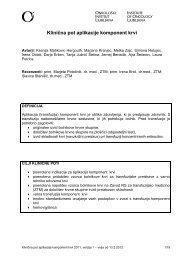Create successful ePaper yourself
Turn your PDF publications into a flip-book with our unique Google optimized e-Paper software.
Cathepsin X interacts with integrin molecules regulating<br />
cell adhesion<br />
Nata{a Obermajer, Zala Jevnikar, Bojan Doljak and Janko Kos<br />
Faculty of Pharmacy, Department of Pharmaceutical Biology, University of Ljubljana,<br />
Ljubljana, Slovenia<br />
Cathepsin X displays distinctive distribution profile in the cells of the immune system.<br />
Its mature form, determined by ELISA is present in large amounts in monocyte/<br />
macrophage cell lines U-937 and KG-1, either in cytosols or cell membrane fraction.<br />
In T cells Mo-T the levels of the mature enzyme were lower. Similarly, confocal laser<br />
scanning microscopy (CLSM) revealed intense membrane staining in differentiated<br />
U-937 and KG-1 cells and weaker staining in Mo-T cells. In these cells cathepsin<br />
X was significantly co-localised with β-integrins, molecules responsible for cell<br />
adhesion and signalling.<br />
By using MTS test we determined the impact of cathepsin X on the adhesion of<br />
pro-monocyte U-937 cell line. Inhibitor of cysteine proteases E64, inhibitors of<br />
cathepsin X CA-074 and CA-074Me and neutralizing monoclonal antibody 2F12<br />
against cathepsin X significantly decreased the adhesion of U937 cells, previously<br />
differentiated by phorbol 12-myristate-13-acetate (PMA). Chicken cystatin showed<br />
only a moderate decrease of adhesion, whereas monoclonal antibody against<br />
another cysteine proteinase, cathepsin B, showed no influence at all. U937 cells,<br />
differentiated by PMA adhere to plastic via α M<br />
β 2<br />
integrin, and inhibition of adhesion<br />
triggers apoptosis (anoikis) in detached cells. Obviously, the inhibitors capable of<br />
impairing cathepsin X activity enhance apoptosis of U937 cells by decreasing the<br />
adhesion to plastic surface, indicating an important function this enzyme might have<br />
in regulation of the activity of α M<br />
β 2<br />
integrin (Mac-1). This effect was also pronounced<br />
on fibrinogen-coated surfaces, but not on fibronectin and matrigel where Mac-1<br />
receptor is not involved in adhesion.<br />
Our results demonstrate that in immune cells cathepsin X interacts with integrin<br />
molecules and may activate Mac-1 receptor. Further studies, including modelling of<br />
cathepsin X expression by gene transfer and siRNA silencing will reveal more details<br />
of the function of this enzyme in immune and tumour cells.<br />
p2597

















